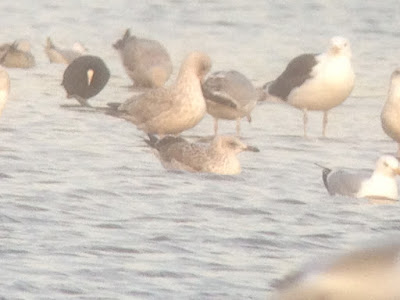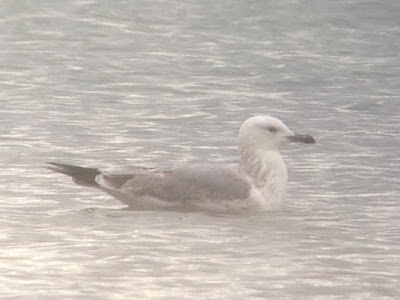I decided to walk around the whole of the lake. I don't often do this, as it is often unproductive and at the moment is also extremely muddy and not pleasant to walk. However, it paid off this morning. In the SE corner, a group of three Lesser Redpolls flew in to lakeside alders with eight Siskins giving nice close views until they flew back south. In the eastern wet meadow, a quick glance along the small brook found a nice Water Rail probing away amongst the vegetation. I watched it for some time, but it never revealed itself totally for a nice record, so this is all I got.
I walked a bit further and suddenly heard a Nuthatch calling. It then started to sing and I soon found a pair in one of the trees in the NE corner, the male was displaying away - another hole filled.
On the north side, several blobs on the overhead wires proved to be Meadow Pipits. I eventually counted 18 and there were probably more, so maybe a sign of some movement.
I moved onto Emmett's farmland. About 100 yards up the track, it was obvious that a large flock of small birds were flying from the hedges to feed on the cut game cover and then flying back again. I worked my way slowly towards them and was soon near enough to get reasonable views of what was predominantly Chaffinch, about 100 birds. Intermingled were at least four Lesser Redpoll and a few Yellowhammers and Reed Buntings; a flock of about 50 Linnets were generally separate. I continued to watch the finches thinking that there must be a Brambling in there somewhere and sure enough, it wasn't long before I spotted an orange breasted bird with white undersides - a nice male Brambling. I was very pleased with this as it was another patch tick. It soon vanished from view in the flighty flock, but with continued watching, I picked it out again in the middle of the field along with a female. Trying to get a record shot was impossible and the two soon flew to the other side of the field when a tractor came up the track. I could pick them both out with a scope in the far side hedge, but no photos.
While all this was going on, I could hear the plaintive whistles of Golden Plover from behind me and sure enough a flock of about 80 birds were once again sitting on one of the bare fields. So all in all, a pleasing morning to be out on patch.












